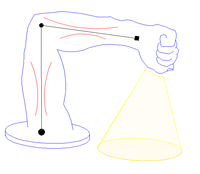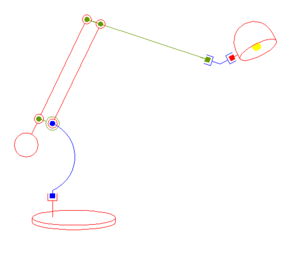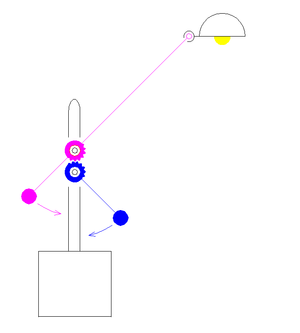Balanced-arm lamp


A balanced arm lamp is a lamp with an adjustable folding arm. Other names for an arm lamp are: Spot light or lamp, task light or lamp, hobby lamp, desk lamp, swing arm lamp, Architects lamp, Articulated arm lamp.
If we compare this type of lamp arm with a human Arm, then the lamp-cap is connected with the "wrist", the wrist is connected with the fore-arm, the fore-arm is connected with the upper arm and the upper-arm is connected with the body.
Lamp brands like the Anglepoise lamp and Luxo L1 have used this principle.
The arm has been employed in other devices where it is necessary to hold an object stationary at a convenient point in space, notably the copy holder for typists and in some applications, the computer display screen.
Balanced arm lamp types
There are different methods to balance the lamp cap with a pivoting arm lamp. Some lamps have 2 Coil springs on both side of the lamp. These Coil springs make exactly the same movement. In that case we talk about one spring instead of a set of springs.
2 parallelogram & 2 Extension spring sets
File:Luxo L1 black 2006-08-02.jpg
- A Luxo L-1 type of lamp with 2 parallelogram & 2 Extension spring sets.
The fore-arm lifts the lamp-cap.
One strong extension spring controls the parallelogram having 2 bars (fore-arm)
A more stronger spring set controls the parallelogram having 3 parallel bars in a triangle , that lifts the fore-arm and lamp cap.

There is a cheaper version of this type of lamp with 2 parallel bars in the upper arm, this arm is less stable.
If you rotate the arms the lamp-cap keeps pointed in the same direction.
The "body" can turn horizontal.
The body is connected to a stable foot.
single fore-arm, 1 parallelogram , 2 extension springs
The fore-arm of this lamp is a single arm.
If you rotate the fore arm the lamp makes the same rotation.
The "body" can turn in a Horizontal plane.
The body is connected to a stable foot.
Extension springs in the arms
En arm lamp like the Tolomeo desk lamp work this way.
This lamp haves no parallelogram upper arm. In this modern lamp the extension springs are hiden in the arms.
The lamp-cap rotates the same direction as the upper-arm and fore-arm
The "body" can turn horizontal.
The body is connected to a stable foot.
compression springs in the arms
The short arms (green) stay parallel.
One spring puts pull force on the blue arm.
(If the blue arm is tilted back the second spring on this arm gets push force)
The blue arm controls the two parallel arms (red)(upper-arm).
The other spring puts pull force on the other blue arm.
This arm controls the fore-arm(magenta)
The two springs can be the same size
one spring haves to lift more weight but more vertical.
The other spring lift Less weight but more horizontal.
The "body" can turn horizontal.
The body is connected to a stable foot.
Extension spring balanced arm supports a flexible arm
This lamp haves a stiff flexible tube arm to lift the lamp cap and haves a spring balanced arm to support it near the middle.
That way there is a flexible lamp with a long reach.
Extension spring rolls over 2 wheels
The wheel to controls the fore arm is smaller than the wheel that controls the upper arm.
2 arm 1 spring 1 set of Tooth wheel
With dis technique the extension spring haves a double function.
This is not a common arm-lamp system jet.
One spring controls the fore-arm and the upper-arm.
The "body" can turn horizontal.
The body is connected to a stable foot.
Extension springs near the foot
The springs are not lifted by the arms
The springs are more out of view.
1 parallelogram & 2 Extension spring sets
File:Angle poise type of lamp.png
An lamp type like the anglepoise lamp has 1 parallelogram & 2 Extension springs.
One spring controls the shortest arm of a parallelogram.
Parallel on this shortest arm there is the "fore-arm"
To keep these arm parallel there is a are two other parallel arms (upper-arm) that are controls by a second extension spring.
The "body" can turn horizontal.
The body is connected to a stable foot.
Pressure springs near the foot
This technique is a little bit different.
One pressure Spring (device) controls a very short arm (grey)
The Roller chain,cable, connect this arm parallel to the "fore-arm" (yellow).
The longer other spring controls the blue arm.
The "body" (red) can turn horizontal.
The body is connected to a stable foot.
The body can be smaller be-course the Pressure springs can stick out at the undersides of the body.
In Tension (physics) state the Pressure springs is smaller than the expansion spring.
Pressure and expansion springs
Some springs can make some unwanted resonate noise.
1 Pressure spring near the foot
1 Pressure spring controls a photographic arm
Popular American lamp
Popular American lamp
Spiral spring controls a pantograph arm
File:Spiral spring controls a pantograph arm lamp.PNG
patent: GB1290891A from 1970
torsion springs controls the pivoting arm
squeezing en friction rubber arm
Be course the gravity the rectangle form becomes a parallelogram form The space between the Long arms get smaller The rubber gets pressure and gives friction.
Lamps with counter weights
Some Classical mechanics and Torque
Newtons formula
We define the turning effect with the equation:
Moment = Force × Perpendicular distance from the pivot
Since force is measured in newtons (N) and distances in metres (m) the unit for a moment is the newton-metre (Nm).
Moments can act in two ways: clockwise or anticlockwise.
Force × distance = Moment = Force × distance
1Kg = 10 (N) Newtons
2 balancing arm & 2 Counter weight
A lamp type like the Tizio works like this.
A balancing arm haves on one side of an axis a small counterweight and on the other side a lamp-cap.
This arm is the fore-arm.
These parts are lifted by a second bigger balancing arm that has on the other side of a second axis a more heavy counterweight.
This is the upper-arm.
The two weights has a height from the floor position, A heavy foot keep the lamp stable.
Newtons Formula:
Lamp cap x fore-Arm = Arm x Small weight
(lamp cap + Small weight) x upper-arm = Arm x Big weight.
The WILFRID BUQUET lamp from 1929 works the same.
The two axis have a different angle, dis haves some advances.
Patent GB285045
Click to view
1 Counter weight
Lamp having a chain to keep the arm with the Counterweight and "fore-arm" parallel
So if the lamp and Counterweight moves in the direction of the base and reversed.
In this system the weight does not have to compensate the smaller weight, the arm can lift a more heavy lamp-cap with longer arms.
A heavy standard is needed to keep the lamp stable.
Distance 1 = Lamp-cap to base
Distance 2 = counterweight to base
Lamp-cap weight x distance 1 = counterweight x distance 2
1 Parallelogram + 1 Counterweight
This lamp has a heavy standard , with hinged on a parallelogram pantograph construction formed by bars
The two parallel long bars and two parallel short bars
Which are all hinged on each other
One long bar extends past the parallelogram construction and haves a Counterweight
The short bar also extends past the parallelogram construction and haves a lamp cap
Distance 1 = Lamp-cap to base
Distance 2 = counterweight to base
Lamp-cap weight x distance 1 = counterweight x distance 2
1 Parallelogram + 1 extended Counterweight
This lamp works the same.
the construction of this lamp is very simple
The counter weight haves a low position, the lamp needes no heavy foot for Stability.
the Center of gravity. haves a low point
| Force | × | distance | + | Force | × | distance | = | Moment | = | Force | × | distance | |
|---|---|---|---|---|---|---|---|---|---|---|---|---|---|
| Newtons(N) | × | metres (m) | + | Newtons (N) | × | metres (m) | = | newton-metre (Nm) | = | Newtons (N) | × | metres (m) | |
| weight
lamp cap |
distance
lamp cap |
weight
arm |
distance
middle arm |
on the pivot | distance
counter balance |
weight
counter balance | |||||||
| high reach | 4 N | × | 1 m | + | 2 N | × | 0.5 m | = | 5 (Nm) | = | 0.125 m | × | 40 N |
| Lang reach | 4 N | × | 1.5 m | + | 2 N | × | 0.75 m | = | 7.5 (Nm) | = | 0.187 m | × | 40 N |
| reach | 4 N | × | 1.4 m | + | 2 N | × | 0.70 m | = | 7 (Nm) | = | 0.175 m | × | 40 N |
| Low reach | 4 N | × | 900 m | + | 2 N | × | 0.45 m | = | 4.5 (Nm) | = | 0.112 m | × | 40 N |
3 parallelogram & counter weight
Some lamps have an exaggerated complex construction.
2 Counter balanced 1 straight arm lamp
With this lamp the arm goes up and down the movement is very limited but the technique is nice to look at.
One thing is not logic If the fore-arm goes more horizontal the weight is not balanced on both side of the base.
Lamp cap x fore-Arm = (Arm 1 x weight 1) + (Arm 2 x weight 2)
lamps having a vertical axis
This kind of lamp are with weight or springs balanced fore arm
Disadvantages is that the upper-arm can not point up or forwards.
friction arm system
The friction between the twisted arm controls the movement between the arms.
Tighten bold friction
This arm system works with friction
mechanical coupling devices
Gravity locked or cam locked elbow
External link:
http://www.tribtech.com/app.20.htm
European patent :EP1274545
Hydraulic arm
The Biggest Arm-lamps in the world exist in Rotterdam, Netherlands.
pneumatic arm
References
See also
- Angular velocity
- Angular momentum
- axle
- Classical mechanics
- Coil spring
- Elastic
- Engineering science and mechanics
- Fields of engineering
- [[]]
- friction
- Industrial design
- [[]]
- Light fixture
- [[]]
- List of inventors
- List of mechanical engineering topics
- Torsion spring
- Machinery
- Mechanical advantage
- Mechanical engineering
- Mechanical engineering technology
- Moment (physics)
- [[]]
- Noether's theorem
- Patent
- Pantograph
- [[]]
Some drawing table work with a parallel and counter weight.
To adjust the height and the angle of the board
External links
Dutch students from the University Delft Netherlands experimenting to balance a lamp.
in Dutch but with a lot of images
patents history
Classifications IPC :F21V21/26 International patent category : B23B31/171
http://www.delphion.com/cgi-bin/viewpat.cmd/GB191104491 1911 harmonica
US1370231 1921 harmonica arm
GB206435 1923 parallelogram & counter weight
GB254972 1926 friction
GB285045 1929 2 counter weight
GB481198 1934 spring and counter weight
FR757890 1934 CARWARDINE GEORGE
FR784932 1935 CARWARDINE GEORGE
GB470502 1937 friction
GB489547 1938 2 parallelogram 2 springs
GB504791 1939 2 pressure springs
GB536342 19.. a-symmetric arm lamp
GB589994 1947 friction and a spring
GB618344 1949
GB629364 1949 spring in the arm
GB713378 1954 friction arm
US3003737A11961
GB1249774A 1971
US5333103A1 1991
EP0518569 1992
EP1274545 2003 mechanical coupling devices




























